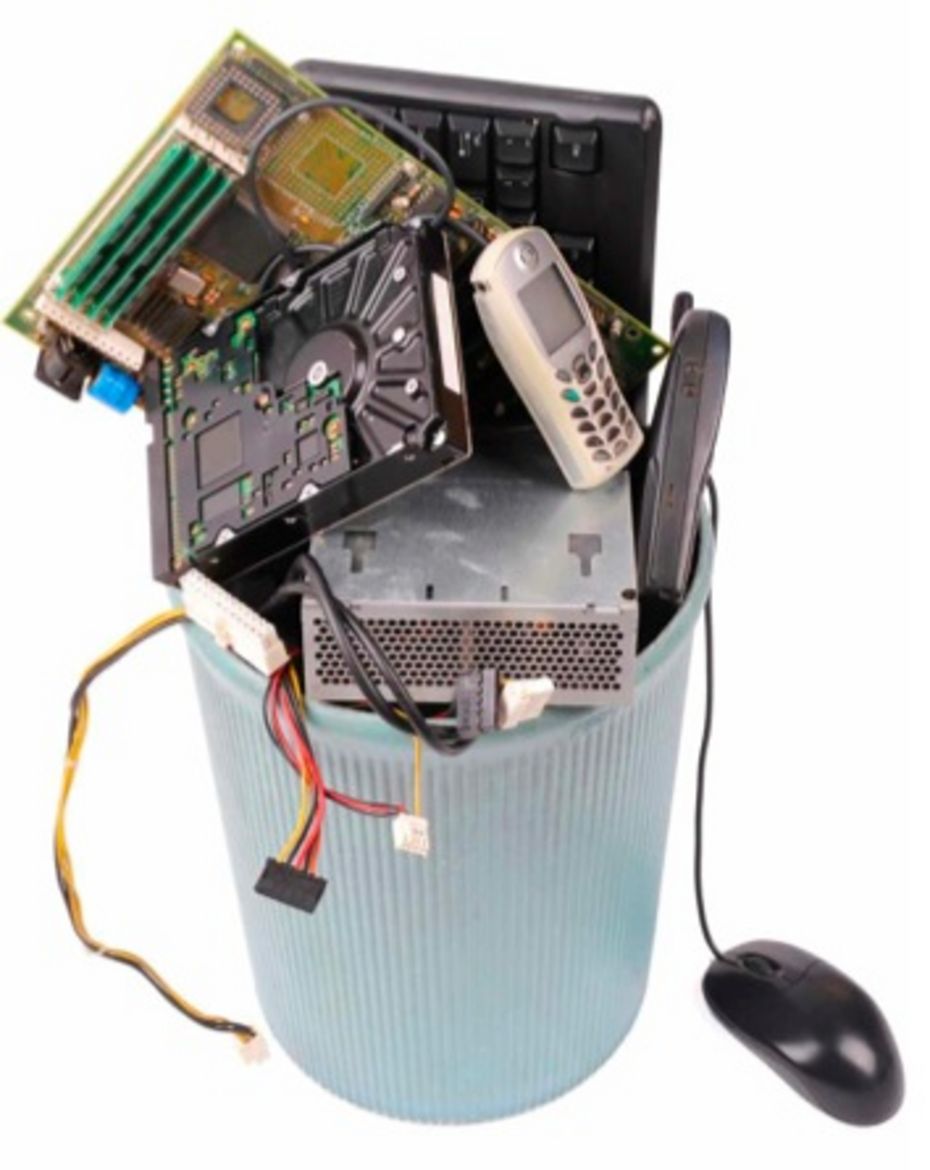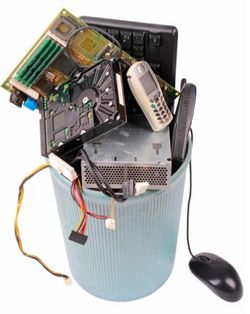Separating

More Gold in Waste than in Mines

Although we are good at separating waste, we could be better at recycling. Dr Christian Hagelüken is Director EU Government Affairs at Umicore AG. The enterprise operates a high-tech facility close to Antwerp where electronic scrap, accumulators and other technical waste are recycled.
An interview by Bert Beyers
Translated from the German by Nadja Gröner, Lea Schiefen, Christin Brauer
What is the situation like in conventional mining?
On average, the amount of gold extracted by mining is below five grams per ton.
Some computer scrap is recycled in threshold countries, in so-called backyard businesses. How efficient is the processing there?
Today, when such printed circuit boards are metallurgically recycled by means of modern, high-quality procedures, it is possible to achieve high yields. We recover far more than 95 per cent of the 200 or 250 grams of gold – and not only gold, but also palladium, silver, copper, tin, antimony and many other components. Backyard businesses are more focused on cherry-picking. Certain valuable metals, especially gold and copper, are recycled. And even for gold, the recovery rate is only in the range of 25 percent. Apart from that, these backyard businesses have a negative impact on the environment.
What metals can be recovered from electronic scrap?
I would not only focus on precious metals, such as gold, silver and palladium, but would also include additional technology metals as cobalt, antimony or indium and base metals such as copper, nickel and tin. Rare earths hold a special position. Technology metals, for example precious and special metals, will become more and more important in the future. You just have to think of electric mobility, photovoltaics or wind power stations. We have a booming demand for these metals, and therefore, recycling is an important component in order to ensure and maintain access to these metals on a long-term basis.
Theoretically, metals can be re-used again and again. But what is the situation really like?
With many technology metals, the recycling quota is below one per cent. Gold from electronic components is recycled up to 15 per cent, but palladium not even 10 per cent.
What are the problems?
Problems occur along the entire recycling chain. Firstly, with insufficient registration, secondly, with inadequate monitoring of material flows after registration, thirdly, with bad and unsuitable recycling procedures and fourthly, the technical limits of recycling pose a problem.
What are the problems when it comes to electronic scrap?
Despite legislation, even our collection rates for many electronic devices are still unsatisfactory. Just think of mobile phones or similar high-quality small equipment for example. Even today, there are still a lot of devices that can actually be considered scrap and that, even in countries outside the EU, do not have a real market value anymore. Nevertheless, these devices get lost due to dubious and illegal exports or low-quality recycling. Street traders that organise house clearances are just one example. The metals can get lost either at local collection points or later in the chain. Many players in the market pass themselves off as recyclers. However, many of them are traders or, at best, pre-processors. The origin of waste management is partially considered as the ‘dirty corner.’ Some people only have money on their mind and have little interest in high-quality recycling and transparent material flows. Ingrained ways of thinking still prevail. However, we need more ethical thinking in the recycling domain.
What are possible solutions?
Within a short period of time, a certification system should be introduced, ensuring that electronic scrap is processed according to high-quality recycling processes along the entire chain to final disposal. This way, transparency of real material flows can be achieved. In my opinion, if we really want to close cycles, we need to provide incentives for consumer goods on a medium-term basis. These should be linked to business models.
An example?
For example, leasing models for products and, in individual cases, also deposit systems. It is not so much a question of calling a product one’s property, but rather a question of using its function in an optimal way. The structure of today’s system, especially in the field of electronics, is that a product is manufactured and then sold. Initial buyers make use of this product for a certain period of time until they resell it perhaps on eBay. One completely loses track of the device. Unless there is goodwill present, we have little reason to return such a device to the high-quality recycling process.
Let’s think ahead.
Any production chain – of a car or a computer – is preceded by sophisticated distribution systems with just-in-time delivery. Every supplier’s part can be precisely located at any time. The supply chain is highly transparent, and supported by technical processes such as labelling, GPS systems or the tracking of truck routes. However, we still find ourselves in the Stone Age when it comes to a product’s end-of-life. In principle, much of the technology used during the production process of an object could be applied to its end-of-life cycle as well. It is also conceivable that certain products of higher value are provided with an RFID tag and can thus be tracked throughout the entire production chain. If you are in a clothing store and take a jacket off the hook, and leave without paying, the alarm is set off at the exit. In principle, the same approach could also work for containers with electronic scrap at the harbour.
How much time did you plan for your vision?
I hope that 20 or 30 years from now at the latest, we will have thought this resource topic through entirely and will have started to tackle it. Then we will have a combination of fully modern technology, high transparency, different business models, and stronger commitment of manufacturers to view end-of-life as an integral part of their products. Furthermore, they are interested in remaining parts and substances being returned in order to guarantee the supply with new products. This will also have an impact on the products’ designs. If, at some point, we have better control of the circulation of used products in Africa …
Like computers, cars and washing machines …
… then these devices will probably also be pre-processed in the best possible way in the region at their end-of-life in order to retrieve more complex parts from them, like printed circuit boards, accumulators or magnets. They can then be transported back to suitable high-tech facilities–wherever those may be located; most likely somewhere in Europe.
 Christian Hagelüken is Director EU Government Affairs at the Belgian materials technology company Umicore S.A/N.V, headquartered in Brussels. Umicore is a world leader in the production and recycling of special material and metals (e.g. cobalt, germanium, nickel, zinc, gold, silver, and platinum group metals). The listed company employs about 14,300 people who generated a turnover of approximately EUR 9.7m in 2010. Customers are manufacturers in the chemical industry, the automotive, building materials, jewellery, and electronic industries. Bert Beyers is an author and journalist. His last publication in factory was about Growth.
Christian Hagelüken is Director EU Government Affairs at the Belgian materials technology company Umicore S.A/N.V, headquartered in Brussels. Umicore is a world leader in the production and recycling of special material and metals (e.g. cobalt, germanium, nickel, zinc, gold, silver, and platinum group metals). The listed company employs about 14,300 people who generated a turnover of approximately EUR 9.7m in 2010. Customers are manufacturers in the chemical industry, the automotive, building materials, jewellery, and electronic industries. Bert Beyers is an author and journalist. His last publication in factory was about Growth.
More articles to the topic of Separating with expressive numbers and citations, nicely illustrated and readable on screens and tablets you will find in our PDF magazine Separating.
Beiträge online
SEPARATING

- The art of separation
- More Gold in Waste than in Mines
- Let’s Break Away from Determined Breaking Points
- Analysing Separately – Thinking and Acting Together!
- Tausche Handy gegen großes Menü
- Meerwasser minus Salz. Trennen fürs Trinkwasser.
News zum Thema
- 06/2014 | Separating: New Topic of Factory-Magazine
- 08/2013 | A Map for sustainable shopping in NRW
Themen
- The Domino Effect: the Mobility Transition as an Engine for the ‘Great Transformation’
- Cities Use the Space
- Decarbonization by 2030
- The fear of biting the hand that feeds you
- Where investing is a pleasure
- Why divestment is going to change the world
- A Robin Hood tax for climate protection
- May the Force Be with Us
- Modern Strategies
- The prerogative of interpreting the future now lies with the companies involved in climate protection”
- From Negotiating to Trading Equitably
- Can a donkey be tragic?
- Rethink rather than rebound: a sufficiency revolution must precede the efficiency revolution
- On Rebound, Prebound and Performance Gaps
- So Let Us Seize Power Then!
- With Common Property Against Political Failure
- So Let Us Seize Power Then!
- The Comforting Beauty of Failure
- “It Is Not Impossible at All.“
- Resource-light shopping
- Men Have Not Stopped Giving the Advantage to Women – So Far
- Toothpaste for Princesses and Soup for Pirates
- It is about equality
- A nice day
- Initiative instead of frustration
- The right ingredients
- Resilient for Life
- Not only, but also
- Appreciation – more please!
- Worth more than money
- Learning to value the value of goods
- Worth and Values
- The Transformative Power of Science
- Historically effective: How innovation and technology transform
- The Disappearance of Products
- Growing Older 101
- Columbus’ Egg
- It Works! In Theory at Least ...
- What If...?
- Analysing Separately – Thinking and Acting Together!
- Let’s Break Away from Determined Breaking Points
- More Gold in Waste than in Mines
- The art of separation
- Should you really DIY?
- The Aesthetics of Do-It-Yourself
- Standing on One’s Own Feet
- From the handaxe to desktop fabrication
- Using Shares to Survive the Crisis
- When Citizens participate
- Possess to Participate
- The Right Growth at the Right Time
- Gunter Pauli and Blue Economy
- When Sustainability Grows
- How we treat Growth
- Illusions about Growth

